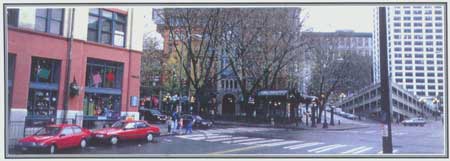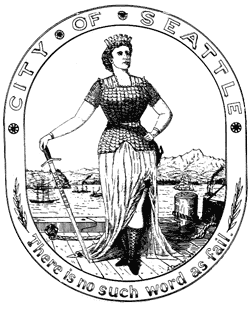|
KLONDIKE GOLD RUSH
Hard Drive to the Klondike Promoting Seattle During the Gold Rush |

|
INTRODUCTION
The Legacy of the Klondike Gold Rush
"It was through the gold rush that Seattle learned the marketing flair it now applies to selling computer software or persuading people to pay $2... for a cup of coffee."The Economist, 1997
Seattle, according to a recent article in The Economist, "is remarkable for its golden touch." The metropolitan area serves as a base for Bill Gates, America's richest man, along with several thousand Microsoft millionaires. The city supports numerous companies recognized as "standard-setters in their businesses," including Boeing, Nordstrom, and Starbucks. Seattle became the largest city in the Pacific Northwest almost a century ago -- and for nearly that long historians and other analysts have examined the reasons for this growth. The Economist has offered an intriguing, if somewhat ahistorical, interpretation: what sets Seattle apart from other successful cities is a series of characteristics resulting from the Klondike Gold Rush of 1897-1898. [1]

Pioneer Square, including the Maynard Building (pictured left),
Pioneer Building (in the middle), and the Hotel Seattle (pictured right)
during the Klondike Gold Rush era, 1899.
(Courtesy Seattle Public Library)
During these years, thousands of prospectors headed for the Far North, passing through San Francisco, Portland, Tacoma, Seattle, Victoria, and Vancouver, British Columbia. Of the approximately 100,000 miners who started for the gold fields, 70,000 used Seattle as their point of departure. [2] For the most part, however, it was not the stampeders who struck it rich. As was the case with other gold rushes in the western United States, it was the merchants who profited from the Klondike Gold Rush -- and Seattle provides an excellent example of how this event encouraged population growth and the development of businesses that outfitted and transported the miners. During the late 1890s, "Klondike" became a "magic word," and Seattle merchants used it to sell a variety of goods and services. [3]

Pioneer Square from a similar vantage point a century later,
1998.
(HRA Photo)
The Klondike Gold Rush fueled a longstanding commercial spirit in Seattle that has continued through the present. John Nordstrom and George Bartell, for example, started companies during this era, providing clothing and supplies -- and both remain thriving businesses today. As The Economist observed, the Klondike Gold Rush helped Seattle develop the "marketing flair" now applied to selling computer software and coffee. Few public relations campaigns in American history could match the advertising blitz organized by the Seattle Chamber of Commerce during the stampede to the Yukon and Alaska. As a result of that marketing effort, Seattle became linked to Alaska and the Far North in the public mind. Moreover, according to The Economist, the energetic, risk-taking entrepreneurship that developed in the city during the late nineteenth century remains a "recipe for business achievement." [4]
Of course, this interpretation is very much a product of the 1990s. It is difficult to imagine The Economist printing such an idea 25 years earlier, with Boeing laying off thousands of employees and Seattle's economy plunging into recession. The 1990s, however, have exhibited a resurgence of the commercial success, along with the vitality and energy, that characterized the gold-rush era of the late 1890s and the early twentieth century. As an article in Pacific Northwest observed, during the 1990s Seattle transformed from a "modest place" to "musical mecca, center of the coffee universe, hip tourist destination, hacker heaven and superliveable place." [5] Because 1997-1998 marks the centennial of the Klondike Gold Rush, this seems an especially appropriate time to examine its legacy.
As noted, the Seattle area owes a good measure of its current good fortune to the presence of Microsoft. As chairman of this company, Bill Gates has seen a connection between the gold rush and the development of the software industry. "The Internet," he wrote in 1997, "is another case where people who are selling pans to the prospectors often will do better than the prospectors themselves. Analysts, the people who assemble trade shows, consultants, and others providing internet-related services may have a more sure-fire way of benefiting than the poor prospectors out there wielding picks and axes...." [6] No one in America has demonstrated this point better than Gates. He personifies a quality called "hard drive," which is manifested in the philosophy "work hard, make better products, and win." [7] Persistence and assertiveness are essential components of Microsoft's ethos. [8]
Interestingly, 100 years earlier a miner by the name of Swiftwater Bill Gates (no relation to the current chairman of Microsoft) supposedly leaned from the window of a Seattle hotel, showering gold nuggets from the Klondike on the passersby below. [9] The new "gold rush" of the 1990s has once again brought recognition and prosperity to Seattle.
This proposed design for a city seal illustrated the spirit of
determination that characterized Seattle in 1897.
[Source: Museum of History and Indusry, Seattle.]

Not all historians, however, see the connection between the gold rush and the current economy. Neither do historians agree as to the importance of the gold rush to Seattle's development. Some view it as a pivotal event affecting the course of the city's history. Others argue that the arrival of the transcontinental railroad proved to be far more significant in encouraging population growth and the expansion of local industries that had already gained a foothold in the area. Few historians, however, would deny the importance of the late nineteenth century in the development of Seattle. At the very least, the Klondike Gold Rush coincided with major events, including the arrival of the railroad, and it exemplified continuing trends in the city's history. If not the primary cause of the city's growth and prosperity, the Klondike Gold Rush nonetheless serves as a colorful reflection of the era and its themes, including the celebrated "Seattle spirit."
This Historic Resource Study examines these issues, beginning in the early 1850s with the founding of Seattle, and ending in 1909 with the Alaska-Yukon-Pacific Exposition commemorating the Klondike Gold Rush and the growth of the city. Chapter One describes early Seattle and the gold strike in the Klondike, while the following three chapters analyze how the city became the gateway to the Yukon, how the stampede to the Far North stimulated local businesses, and how the city's infrastructure and boundaries changed during the era of the gold rush. Chapter Five looks at how historians have interpreted the Klondike Gold Rush throughout the twentieth century. The final chapter brings the Klondike story up to the present, describing the establishment of the Pioneer Square Historic District and the Klondike Gold Rush National Historical Park. It also describes the buildings and structures associated with the gold rush that remain standing, emphasizing those that have not yet been recognized or listed in the National Register. These historic resources serve as reminders of the period that, in the words of one observer, "put Seattle on the map." [10]
| <<< Previous | <<< Contents>>> | Next >>> |
hrs/intro.htm
Last Updated: 18-Feb-2003